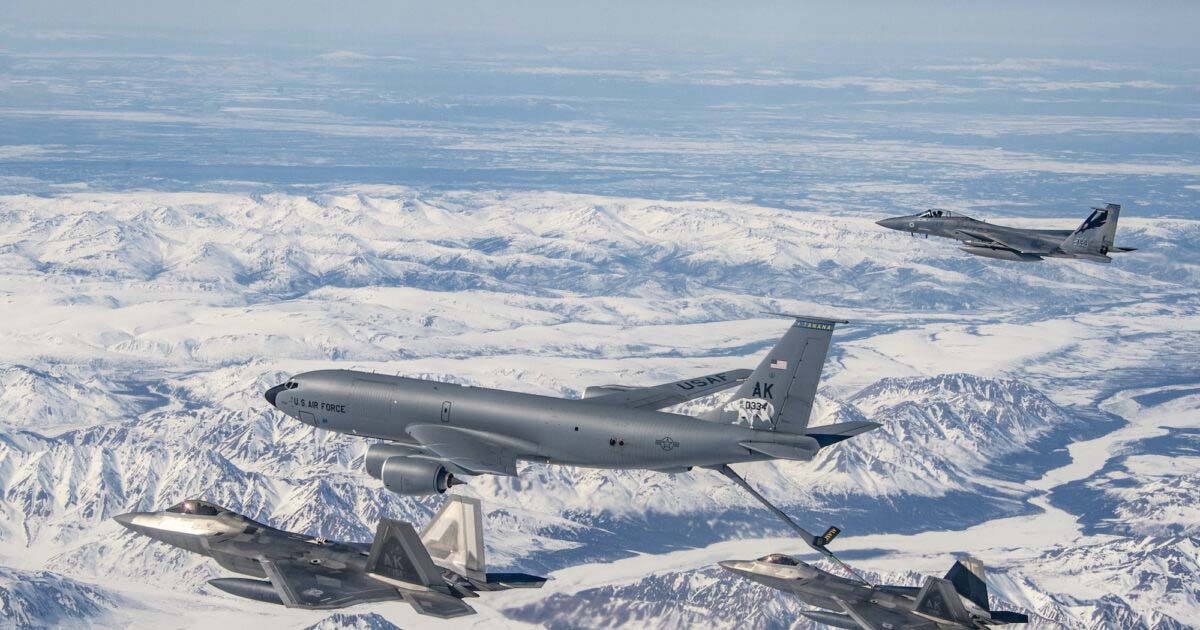The Air Force has grounded hundreds of KC-135 refueling planes until they are inspected for a potentially faulty part in the tail section, officials said this week.
The Air Force ordered the inspections Tuesday for a “non-conforming part in the vertical tail assembly,” according to the U.S. Air Force Materiel Command in a statement published on Wednesday. “The Time Compliance Technical Order restricts flight operations until the approximately 30-minute inspection is completed.”
As of Sunday, about 90 KC-135s have been inspected, the Air Force said, and 24 were found to have non-conforming pins. Planes that were inspected and had the proper pins are now flying again, it said. Officials are also checking variants of the plane, including the RC-135 and W-135 aircraft.
“We’re taking this action out of an abundance of caution, after consulting with our engineering experts,” Col. Michael Kovalcheck, senior materiel leader in the Air Force Life Cycle Management Center’s legacy tanker division, said in a statement. “We are working closely with Air Mobility Command and all operational users and anticipate all potentially affected aircraft will be inspected.”
Last week, the Air Force issued a directive to inspect the planes for possibly faulty pins. The initial order called for the planes to be inspected within 15 days, but now, the new order stipulates that the planes must be inspected or remain grounded.
“Although no mishaps have resulted, leaders elected to accelerate the inspection due to a lack of information to assess the risk of materiel failure in non-conforming parts,” the Air Force statement issued Wednesday said. “Planes that have already been inspected and found with proper pins have already returned to flying status.”
Planes that have faulty pins “will be authorized a one-time flight to a repair location,” the Air Force said, adding that it anticipates the planes “require only a swap out of new pins [and] can be accomplished within a day. Most pin replacement work will likely be accomplished at the Oklahoma City Air Logistics Complex, where the KC-135 fleet also undergoes depot maintenance.”
A memo that was posted to the “Air Force amn/nco/snco” Facebook page last week suggested that more than 200 KC-135s may have faulty pins. The Air Force confirmed the authenticity of the memo to Defense News and other news outlets, while The Epoch Times has contacted the Air Force for comment.
“Worst case scenario if not fixed the vertical stab would fall off in flight,” the page claimed in its post, dated Feb. 9. The memo echoed those concerns, saying that if one pin failed, there would be catastrophic consequences.
“Should one pin fail, the other would not be able to carry the remaining load and the vertical stabilizer would depart the aircraft,” the memo stated. The vertical stabilizer, also known as the tail fin, is used to provide stability to the plane.
That memo also said the Air Force bought 280 fitting pins from a supplier between 2020 and 2022. A later quality inspection concluded that the parts were faulty, it said. From the memo, it’s not clear how many of the faulty pins were installed.
A number of CV-22 Ospreys are still not able to fly because clutch components need to be replaced, according to a report earlier this month.
An Air Force fact sheet shows the armed service has about 414 Stratotankers, and about 247 are managed by the reserve and guard component.
“Through the years, the KC-135 has been altered to do other jobs ranging from flying command post missions to reconnaissance. RC-135s are used for special reconnaissance and Air Force Materiel Command’s NKC-135As are flown in test programs. Air Combat Command operates the OC-135 as an observation platform in compliance with the Open Skies Treaty,” it says.
Notably, Boeing KC-135 Stratotankers, made by Boeing, were used during a recent U.S. military interception of Russian aircraft near Alaska’s Air Defense Identification Zone (ADIZ) earlier this week. In those incidents, F-35 jets were accompanied by KC-135s and other aircraft as a handful of Russian fighter jets and bombers approached the ADIZ in what U.S. Northern Command and NORAD said was a routine operation.
KC-135s have been used in a variety of U.S. military operations since its first flight in 1956, although it was used extensively during the Vietnam War and later, Operation Desert Storm in Iraq.













Be very interesting to know who the “supplier” was for the pins. I don’t think it was Boeing.
Wow ! I served in the AF in 1960 and worked on KC-135’s as an airborne radio and radar technician. I am now going on 83-years old. How long will the AF continue to use these airborne dinosaurs ?
WTF!!?
Similar to a 1951 movie ‘No Highway in the Sky’.